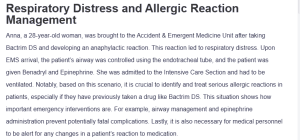Respiratory Distress and Allergic Reaction Management
Anna, a 28-year-old woman, was brought to the Accident & Emergent Medicine Unit after taking Bactrim DS and developing an anaphylactic reaction. This reaction led to respiratory distress. Upon EMS arrival, the patient’s airway was controlled using the endotracheal tube, and the patient was given Benadryl and Epinephrine. She was admitted to the Intensive Care Section and had to be ventilated. Notably, based on this scenario, it is crucial to identify and treat serious allergic reactions in patients, especially if they have previously taken a drug like Bactrim DS. This situation shows how important emergency interventions are. For example, airway management and epinephrine administration prevent potentially fatal complications. Lastly, it is also necessary for medical personnel to be alert for any changes in a patient’s reaction to medication.
Ventilated Clients and Pneumonia Risk
Patients on mechanical ventilation are at a higher risk for developing ventilator-associated pneumonia (VAP) as compared to non-ventilated patients. The placement of the ETT removes barriers unique to the respiratory system to trap bacteria from gaining access to the lungs (Kohbodi et al., 2023). Furthermore, secretions can stagnate in the tube, which brings bacterial growth, and using an artificial airway hinders coughing, thus creating a high risk of infection.
Nursing Interventions to Prevent Pneumonia
Several critical nursing interventions can be taken to avoid VAP. First, there should be proper oral hygiene with the use of chlorhexidine in order to avoid the transfer of a large number of bacteria to the lungs (Zhao et al., 2020). To decrease the possibility of aspiration, the head of the bed should be raised to a 30-to-45-degree angle; suctioning should be done as often as possible. Additionally, humidified oxygen should be applied to clear the airways for moisture clearing.
Allergic Reaction to Bactrim DS
Even though Anna tolerated Bactrim DS in the past, her immune system may have developed a sensitivity to the medication over time. This delayed Type I hypersensitivity can occur after repeated exposure to a drug, causing a more severe immune response upon re-exposure, as seen in Anna’s case.
Complications at IV Site
The redness, swelling, and pain at one of Anna’s intravenous sites suggest phlebitis or inflammation of the vein. The nurse should discontinue the IV line immediately, apply a warm compress to reduce swelling, and select a new IV site using an aseptic technique to prevent infection and further complications (Czysz & Higbee, 2020).
Discharge Instructions
For discharge, Anna must avoid taking Bactrim DS in the future due to the life-threatening risk of anaphylaxis. She should ensure this allergy is documented in her medical records and inform all healthcare providers. Additionally, Anna should consider wearing a medical alert bracelet to alert others to her allergy in emergencies. She should also be educated on recognizing early symptoms of allergic reactions, such as hives, and the importance of seeking immediate medical care if they occur.
References
Czysz, A., & Higbee, S. L. (2020). Superficial Thrombophlebitis. PubMed; StatPearls Publishing. https://www.ncbi.nlm.nih.gov/books/NBK556017/
Kohbodi, G. A., Rajasurya, V., & Noor, A. (2023). Ventilator-associated Pneumonia. PubMed; StatPearls Publishing. https://www.ncbi.nlm.nih.gov/books/NBK507711/
Zhao, T., Wu, X., Zhang, Q., Li, C., Worthington, H. V., & Hua, F. (2020). Oral hygiene care for critically ill patients to prevent ventilator-associated pneumonia. Cochrane Database of Systematic Reviews, 12(12). https://doi.org/10.1002/14651858.cd008367.pub4
ORDER A PLAGIARISM-FREE PAPER HERE
We’ll write everything from scratch
Question
Module 04 Respiratory Case Study
Competency: Select nursing interventions for clients with complex disorders.Instructions:
Scenario: Anna is a 28-year-old female who was prescribed Bactrim DS for a Urinary Tract Infection. She took her first dose of medication yesterday. Anna has taken Bactrim DS in the past, but today, woke up with hives all over her legs and arms. She was also wheezing and could not catch her breath. Her roommate was very worried about her and decided to call 911. When EMS arrived, Anna was not able to talk and was in respiratory distress. Because Anna was in severe respiratory distress, EMS took the measure of securing her airway by inserting an endotracheal tube (ETT). Once Anna’s airway was securely managed, EMS then gave her a dose of Benadryl and Epinephrine prior to transporting her to the hospital. These medications will help decrease the manifestations of the allergic reaction. Anna remains ventilated and is admitted to the ICU for further care.
Answer the following questions related to this scenario:
- Why are ventilated clients at risk for pneumonia? Explain your response.
- What nursing interventions can be taken to prevent pneumonia? Explain the rationale for your response.
- The patient most likely had an allergic reaction to the Bactrim DS that she was taking. Why did the reaction occur even though Anna has taken this medication before without any problems?
- The patient has multiple intravenous lines. One of the intravenous IV sites is red and the patient winces in pain when the nurse palpates around the site. The site is slightly swollen. What complication does the nurse suspect? What action should the nurse take to prevent further complication at the compromised site?
- The patient has a full recovery and is ready for discharge. What discharge instructions would you provide to the patient regarding future administration of Bactrim DS?
Respiratory Distress and Allergic Reaction Management
Format:
- Standard American English (correct grammar, punctuation, etc.)
- Logical, original and insightful
- Professional organization, style, and mechanics in APA format
- Submit document through Grammarly to correct errors before submission
Submit your completed assignment by following the directions linked below. Please check the Course Calendar for specific due dates.
Save your assignment as a Microsoft Word document. (Mac users, please remember to append the “.docx” extension to the filename.) The name of the file should be your first initial and last name, followed by an underscore and the name of the assignment, and an underscore and the date. An example is shown below:


